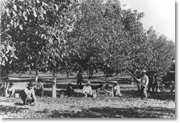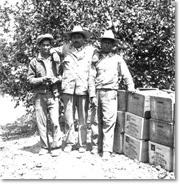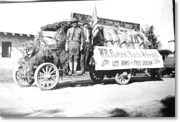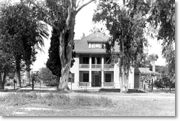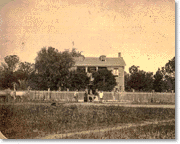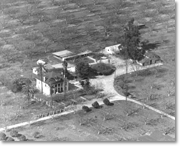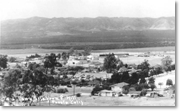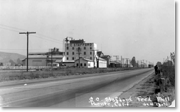How do I...?
Community History |
Frequently Asked Questions |
Local History Materials |
Image Gallery
Community Links |
Library History |
Community Profile
- What can you tell me about the early history of the area?
- What can you tell me about the agriculture of La Puente Valley?
- What can you tell me about railroads in La Puente Valley?
- What can you tell me about the suburban development of La Puente Valley?
- What can you tell me about the John Rowland and William Workman families and ranches?
- What can you tell me about North Whittier Heights, now called Hacienda Heights?
- What can you tell me about the Native Americans of La Puente Valley?
- What can you tell me about La Puente Valley and the city of La Puente?
- What can you tell me about the schools of La Puente Valley?
 1. What can you tell me about the early history of the area?
1. What can you tell me about the early history of the area?
Though originally inhabited by Gabrielino Indians, Europeans first made their mark on the area when La Puente Valley was claimed by the Spanish government starting with the 1771 founding of the San Gabriel Mission. Aided by good soil, plentiful water, and lots of Native American labor, the mission became the wealthiest in the state of California. Following Mexico's independence from Spain in 1822, Mexico during the 1820s and 1830s secularized the missions and gave away or sold their properties. John Rowland and William Workman were among the early European settlers drawn to California by such an enticing opportunity for land. In November 1841, they arrived with a wagon train of settlers from New Mexico; traveling well over a thousand miles through desert and mountain terrain to reach their new home.
 Early in 1842, Rowland and Workman applied for a land grant from Governor
Juan B. Alvarado at Monterey-then the state capital-and obtained title to the
nearly 49,000-acre Rancho La Puente for only $1,000 in gold and a pledge to
hire the local Native Americans. Rancho La Puente prospered and by 1850 was
practically self-sufficient. Though the two men split the property in 1851,
they continued working the land successfully with grist mills, cattle ranching,
wheat growing, and wine and brandy production. Rowland's property was divided
among heirs following his natural death in 1873, while Workman's was
relinquished to a creditor following failure of a bank he helped found-a
tragedy which led him to commit suicide in 1876. Though their properties were
later subdivided and developed as towns and cities, the valley remained mostly
agricultural through the mid-1900s. However, in the early twentieth century
the Valley was also the site of considerable industrial development in the oil,
banking, and commercial industries. More information about the early history
of La Puente Valley can be found in the following sources:
Early in 1842, Rowland and Workman applied for a land grant from Governor
Juan B. Alvarado at Monterey-then the state capital-and obtained title to the
nearly 49,000-acre Rancho La Puente for only $1,000 in gold and a pledge to
hire the local Native Americans. Rancho La Puente prospered and by 1850 was
practically self-sufficient. Though the two men split the property in 1851,
they continued working the land successfully with grist mills, cattle ranching,
wheat growing, and wine and brandy production. Rowland's property was divided
among heirs following his natural death in 1873, while Workman's was
relinquished to a creditor following failure of a bank he helped found-a
tragedy which led him to commit suicide in 1876. Though their properties were
later subdivided and developed as towns and cities, the valley remained mostly
agricultural through the mid-1900s. However, in the early twentieth century
the Valley was also the site of considerable industrial development in the oil,
banking, and commercial industries. More information about the early history
of La Puente Valley can be found in the following sources:
Website Links:
Print Sources:
- Rowland, Leonore. Romance of La Puente Rancho. 1958.
- History of La Puente Valley, California. La Puente Journal, 1960.
Images:
- Aerial view of the Workman-Temple homestead, 1921
[Courtesy of the Workman and Temple Family Homestead Museum] - Aerial view of La Puente Valley and Hacienda Heights area, 1935
[Courtesy of the Workman and Temple Family Homestead Museum] - Panoramic view of the La Puente Valley looking south, c. 1940s
[Courtesy of the La Puente Valley Historical Society]
 2. What can you tell me about the agriculture of La Puente Valley?
2. What can you tell me about the agriculture of La Puente Valley?
The agricultural legacy of La Puente Valley and especially of Hacienda Heights,
goes back at least as far as the 1771 Spanish settlement of the San Gabriel
Mission, whose land was used for ranching and grazing purposes. After John
Rowland and William Workman arrived in 1841 and started working the nearly
49,000-acre Rancho La Puente, they began what soon became a self-sufficient
agricultural enterprise of raising cattle and sheep, growing and milling wheat,
and cultivating grapes and fruits for brandies and especially for wines, for
which both men were renowned (Rowland was the first large-scale commercial wine
manufacturer in California). They split their holdings in 1851, with Rowland
 receiving about 29,000 acres on the eastern half and Workman getting the
remaining westerly 20,000 acres, but both men continued their agricultural
pursuits. Rowland was able to keep his property financially afloat despite
ravaging droughts of the 1860s, and following his 1873 death his heirs held out
on selling his property en masse, preserving much of it as open space as late
as the second half of the twentieth century. Workman's property met a sadder
fate, as he forfeited almost his entire estate following the 1875 failure of
the Temple-Workman bank he founded with his son-in-law, Francisco Temple, the
collapse of which caused him to kill himself the following year.
receiving about 29,000 acres on the eastern half and Workman getting the
remaining westerly 20,000 acres, but both men continued their agricultural
pursuits. Rowland was able to keep his property financially afloat despite
ravaging droughts of the 1860s, and following his 1873 death his heirs held out
on selling his property en masse, preserving much of it as open space as late
as the second half of the twentieth century. Workman's property met a sadder
fate, as he forfeited almost his entire estate following the 1875 failure of
the Temple-Workman bank he founded with his son-in-law, Francisco Temple, the
collapse of which caused him to kill himself the following year.
However, by the time of their deaths both men had established an agricultural
legacy that continued for decades. In the early twentieth century, cattle and
sheep ranching gave way to avocado and walnut groves and citrus trees laden
with lemons, oranges, and grapefruit. Growers in North Whittier Heights - the
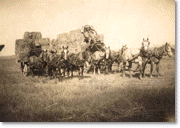 predecessor community to Hacienda Heights - started the North Whittier Heights
Citrus Association and opened a packing plant near Ninth and Clark avenues,
around which grew a settlement called Hillgrove. At one point, Hacienda
Heights' flatlands were among the best walnut-producing areas of the state.
La Puente also became known for its fruit and walnut groves. During the 1930s,
it was the site of the world's then-largest walnut-packing plant. However,
insects, disease, and over-population spurred by a post-World-War-II building
and population boom proved to be the triple undoing of the valley's
agricultural character. During the 1950s and 1960s, residential, commercial,
and industrial development replaced agriculture in the valley. More
information about the agriculture of the area can be found in the following
sources:
predecessor community to Hacienda Heights - started the North Whittier Heights
Citrus Association and opened a packing plant near Ninth and Clark avenues,
around which grew a settlement called Hillgrove. At one point, Hacienda
Heights' flatlands were among the best walnut-producing areas of the state.
La Puente also became known for its fruit and walnut groves. During the 1930s,
it was the site of the world's then-largest walnut-packing plant. However,
insects, disease, and over-population spurred by a post-World-War-II building
and population boom proved to be the triple undoing of the valley's
agricultural character. During the 1950s and 1960s, residential, commercial,
and industrial development replaced agriculture in the valley. More
information about the agriculture of the area can be found in the following
sources:
Website Links:
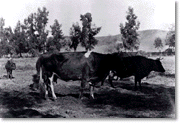
Print Sources:
- Nevins, John A. The Puente Area [microform]: A Study of Changing Agricultural Land Use. Los Angeles, CA: University of California, Los Angeles, 1951.
3. What can you tell me about railroads in La Puente Valley?
Though railroad line building in the late 1800s was inextricably linked to development of western states, it met with opposition from a number of ranchers who were worried that trains would mark the end of a need for horses and a demand for hay and barley. John Rowland and William Workman, the fathers of post-mission settlement in La Puente Valley who in the 1840s received title to the 49,000-acre Rancho La Puente, did not want to give the Southern Pacific Railroad a hundred-foot wide right-of-way between the San Gabriel River and Spadra, saying that it was unnecessary and would be bothersome. They were later persuaded to change their minds and did allow the railroad to be built across their property in the 1870s. Five years later the Santa Fe Railway started a competing line which led to fare wars and brought settlers to the area by the thousands. In 1902, the San Pedro, Los Angeles & Salt Lake Railway-later called the Union Pacific-was also built through the Valley. During the region's agricultural heyday through the mid-twentieth century, the railroads also transported avocados, citrus fruit, and walnuts to an ever-widening market. More information about railroads and La Puente Valley can be found in the following sources:
Print Sources:
- History of La Puente Valley, California. La Puente Journal, 1960.
 4. What can you tell me about the suburban development of La Puente Valley?
4. What can you tell me about the suburban development of La Puente Valley?
La Puente Valley was agricultural in character until the mid-twentieth century. Cattle and sheep ranching were common on Spanish missions being established starting in the 1770s, and through the 1800s with the arrival of thousands of settlers attracted by the prospect of free or cheap land being offered by the Mexican government after it secularized the missions. But the agricultural character of the valley gave way to development starting in the 1950s, as a post-war population and building boom necessitated the building of housing on a massive scale and eventually replaced avocados, citrus and walnut groves with housing, commercial, and industrial development. More information about the suburban development of La Puente Valley can be found in the following sources:

Website Links:
Images:
- Aerial view of La Puente Valley and Hacienda Heights area, 1935
[Courtesy of the Workman and Temple Family Homestead Museum] - Aerial view of Hacienda Heights, 1965
[Courtesy of the Workman and Temple Family Homestead Museum]
 5. What can you tell me about the John Rowland and William Workman families and ranches?
5. What can you tell me about the John Rowland and William Workman families and ranches?
John Rowland and William Workman were friends and business partners who led a wagon train of settlers across more than a thousand miles of desert and mountain terrain from New Mexico to Southern California, arriving in La Puente Valley in November of 1841. They were among the first settlers to obtain a land grant from the Mexican government for properties being given away or sold at bargain prices as part of the secularization of Spanish missions. Their arrival in the valley was a watershed event, for they were the first white men to obtain title to the 48,790-acre Rancho La Puente and to develop it as Anglos into a thriving agricultural enterprise.
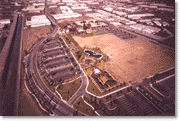 Rowland, born to British parents who immigrated to New York, moved to Boston
while still a young man. There he met a group of fur trappers and headed west,
ultimately finding employment with the American Fur Company in Taos, New
Mexico. There, he met William Workman, who was born in England but came to
America and gravitated to Taos, where he ran a general store and grist mill.
Rowland was jovial and friendly, whereas Workman was more the strong, silent
type. Though the two men's temperaments represented a study in contrasts,
they both possessed excellent leadership qualities and good judgment and
became friends and business partners for life.
Rowland, born to British parents who immigrated to New York, moved to Boston
while still a young man. There he met a group of fur trappers and headed west,
ultimately finding employment with the American Fur Company in Taos, New
Mexico. There, he met William Workman, who was born in England but came to
America and gravitated to Taos, where he ran a general store and grist mill.
Rowland was jovial and friendly, whereas Workman was more the strong, silent
type. Though the two men's temperaments represented a study in contrasts,
they both possessed excellent leadership qualities and good judgment and
became friends and business partners for life.
 In September 1841, Rowland and Workman traveled west from Taos, leading a
group of several dozen other settlers from Missouri and New Mexico, in what
was the first officially-documented immigrant wagon train comprised of people
interested in new homes, scientific discovery, or just plain adventure.
Workman and Rowland took turns riding at the head of the group, accompanied
by their alert collie watchdog, Lobo. The group traveled along the Rio Grande
down the Chihuahua Trail, then to the Gila River and the Colorado River by way
of Yuma. They took a roundabout route to avoid hostile Indians and only had
one unpleasant encounter when the Indians tried to steal their horses and
livestock. In November 1841, they reached San Gabriel via Cajon Pass. Both
men were long used to Mexican customs, having lived for years in New Mexico
and being married to Mexican women, and not long after assuring California
authorities that they would assimilate well into the new territory they found
out that a vast parcel of land named Rancho La Puente had not yet been
allotted.
In September 1841, Rowland and Workman traveled west from Taos, leading a
group of several dozen other settlers from Missouri and New Mexico, in what
was the first officially-documented immigrant wagon train comprised of people
interested in new homes, scientific discovery, or just plain adventure.
Workman and Rowland took turns riding at the head of the group, accompanied
by their alert collie watchdog, Lobo. The group traveled along the Rio Grande
down the Chihuahua Trail, then to the Gila River and the Colorado River by way
of Yuma. They took a roundabout route to avoid hostile Indians and only had
one unpleasant encounter when the Indians tried to steal their horses and
livestock. In November 1841, they reached San Gabriel via Cajon Pass. Both
men were long used to Mexican customs, having lived for years in New Mexico
and being married to Mexican women, and not long after assuring California
authorities that they would assimilate well into the new territory they found
out that a vast parcel of land named Rancho La Puente had not yet been
allotted.
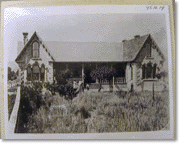 In January 1842, Rowland applied on behalf of himself and Workman to Governor
Juan B. Alvarado for the 48,790-acre land grant of the ranch, one of twenty-two
ranches that had belonged to the San Gabriel Mission. Rowland and Workman had
several factors on their side, including letters of recommendation from Padre
Tomas Estenaga of the San Gabriel Mission and the Prefect of the Second
District of California; their pledges to become Mexican citizens; their
promise to hire local Native Americans; and their willingness to pay a
thousand dollars in gold for taxes and assessments. On January 4, 1842,
Governor Alvarado gave them preliminary title to the land. (It would be
three more years before they would receive permanent title from Governor
Pio Pico.) By the end of 1842, additional settlers from New Mexico had
arrived to become part of the new ranching enterprise.
In January 1842, Rowland applied on behalf of himself and Workman to Governor
Juan B. Alvarado for the 48,790-acre land grant of the ranch, one of twenty-two
ranches that had belonged to the San Gabriel Mission. Rowland and Workman had
several factors on their side, including letters of recommendation from Padre
Tomas Estenaga of the San Gabriel Mission and the Prefect of the Second
District of California; their pledges to become Mexican citizens; their
promise to hire local Native Americans; and their willingness to pay a
thousand dollars in gold for taxes and assessments. On January 4, 1842,
Governor Alvarado gave them preliminary title to the land. (It would be
three more years before they would receive permanent title from Governor
Pio Pico.) By the end of 1842, additional settlers from New Mexico had
arrived to become part of the new ranching enterprise.
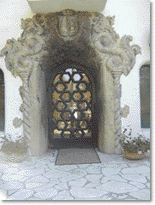 When it came to the business of running Rancho La Puente, Rowland and Workman
had the Midas touch. They built stately adobe houses on the banks of San Jose
Creek and soon established a successful ranching and farming operation. They
raised cattle and sheep, grew wheat and processed it on-site at grist mills,
and produced wool, wine, and brandies. In 1851, they decided to split their
property, with Rowland taking about 29,000 acres on the east and Workman
receiving the 20,000 acres on the west. Their land division was officially
sanctioned only in 1867, following a circuitous route through the legal system.
They continued to work their land successfully and showed particular prowess
as winemakers; Rowland became the state's first large-scale commercial wine
manufacturer and Workman's wine was shipped as far away as Boston. Both even
survived a devastating drought during the 1860s that decimated much of their
cattle herd.
When it came to the business of running Rancho La Puente, Rowland and Workman
had the Midas touch. They built stately adobe houses on the banks of San Jose
Creek and soon established a successful ranching and farming operation. They
raised cattle and sheep, grew wheat and processed it on-site at grist mills,
and produced wool, wine, and brandies. In 1851, they decided to split their
property, with Rowland taking about 29,000 acres on the east and Workman
receiving the 20,000 acres on the west. Their land division was officially
sanctioned only in 1867, following a circuitous route through the legal system.
They continued to work their land successfully and showed particular prowess
as winemakers; Rowland became the state's first large-scale commercial wine
manufacturer and Workman's wine was shipped as far away as Boston. Both even
survived a devastating drought during the 1860s that decimated much of their
cattle herd.
 Their luck diverged near the end of their lives, however. Rowland's finances
remained intact until his death in 1873, at which time his estate was
bequeathed to his next of kin. Workman, however, had decided to start a bank
in 1868 with his son-in-law, Francisco Temple. After the bank failed during
the Panic of 1875, Workman-who had put up nearly all of his 20,000 acres as
collateral-lost the property to Elias J. "Lucky" Baldwin, who had lent the
money to start the bank. Devastated, Workman took his own life the following
year. More information about John Rowland and William Workman can be found
in the following sources:
Their luck diverged near the end of their lives, however. Rowland's finances
remained intact until his death in 1873, at which time his estate was
bequeathed to his next of kin. Workman, however, had decided to start a bank
in 1868 with his son-in-law, Francisco Temple. After the bank failed during
the Panic of 1875, Workman-who had put up nearly all of his 20,000 acres as
collateral-lost the property to Elias J. "Lucky" Baldwin, who had lent the
money to start the bank. Devastated, Workman took his own life the following
year. More information about John Rowland and William Workman can be found
in the following sources:
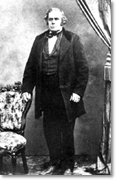
Website Links:
Print Sources:
- Rowland, Donald E. John Rowland and William Workman: Southern California Pioneers of 1841. Western Frontiersmen Series; 27. Spokane: Arthur H. Clark Co.; Los Angeles: Historical Society of Southern California, 1999.
- Hacienda Heights: Growing with Pride. Ideas Unlimited, 1970.
- Rowland, Leonore. Romance of La Puente Rancho. 1958.
 6. What can you tell me about North Whittier Heights, now called Hacienda Heights?
6. What can you tell me about North Whittier Heights, now called Hacienda Heights?
Hacienda Heights is an unincorporated community of more than 40,000 people located on about eleven square miles in eastern Los Angeles County in the San Gabriel Valley. The community was built on property that was originally part of the nearly 49,000-acre Rancho La Puente to which John Rowland and William Workman obtained title after arriving in La Puente Valley in 1841. Workman lost his half of the property in 1875 to lender Elias J. "Lucky" Baldwin after a bank Workman had founded went bankrupt and he had to forfeit his property as collateral. Not long after, the Southern Pacific and Santa Fe railroads built lines through the region that opened it up for development and attracted settlers, and Baldwin began subdividing his property. In 1912, one of his descendants, Anita Baldwin, sold 1,826 acres to Edwin Hart and Jed Torrance, who subdivided the land for agricultural use and named the community North Whittier Heights. The area soon became renowned for its citrus, walnut, and avocado production. Like so many Southern California communities, however, it was transformed after World War II from a quiet agricultural community to a large residential suburb.
 In 1961, North Whittier Heights successfully petitioned to change its name
to Hacienda Heights, and shortly afterward drafted a master plan for its
development. Since then, Hacienda Heights has held several unsuccessful
elections to incorporate as a city that have failed for a variety of reasons,
among them the opinion that its sales tax base is too small and that it is
simply a bedroom community for the nearby City of Industry, which was
incorporated in 1957. In recent years, the community has experienced several
major cultural changes, including the 1988 completion of the Hsi Lai Temple,
the nation's largest Buddhist temple that has attracted a large Chinese
population. However, vestiges of Hacienda Heights' early history remain,
as some of the original homes from Rancho La Puente still stand on a 92-acre
tract of land between Gale Avenue and Valley Boulevard. Other homes of early
settlers are sprinkled around or near Hacienda Heights, some of them the
dwellings of descendants of Rowland and Workman. More information about
Hacienda Heights can be found in the following sources:
In 1961, North Whittier Heights successfully petitioned to change its name
to Hacienda Heights, and shortly afterward drafted a master plan for its
development. Since then, Hacienda Heights has held several unsuccessful
elections to incorporate as a city that have failed for a variety of reasons,
among them the opinion that its sales tax base is too small and that it is
simply a bedroom community for the nearby City of Industry, which was
incorporated in 1957. In recent years, the community has experienced several
major cultural changes, including the 1988 completion of the Hsi Lai Temple,
the nation's largest Buddhist temple that has attracted a large Chinese
population. However, vestiges of Hacienda Heights' early history remain,
as some of the original homes from Rancho La Puente still stand on a 92-acre
tract of land between Gale Avenue and Valley Boulevard. Other homes of early
settlers are sprinkled around or near Hacienda Heights, some of them the
dwellings of descendants of Rowland and Workman. More information about
Hacienda Heights can be found in the following sources:
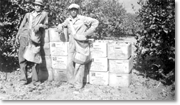
|
Print Sources:
|
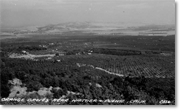
Images:
- Aerial view of La Puente Valley and Hacienda Heights area, 1935
[Courtesy of the Workman and Temple Family Homestead Museum] - Aerial view of Hacienda Heights, 1965
[Courtesy of the Workman and Temple Family Homestead Museum] - Citrus pickers in front of North Whittier Heights Citrus Association crates, c. 1930s
[Courtesy of the La Puente Valley Historical Society] - Orange groves near Whittier and La Puente, c. 1940s
[Courtesy of Cecelia Wictor]
7. What can you tell me about the Native Americans of La Puente Valley?
Before the arrival of Spanish explorers in the region in 1769, the La Puente Valley was inhabited by Gabrielinos, who named the area "Awig-na," meaning "Abiding Place." Gabrielinos were, except for the Chumash, the wealthiest, most powerful, and most populous Native group prior to California's habitation by European settlers. The territory they inhabited in Southern California was vast and included the Los Angeles basin; Los Angeles, Santa Ana, and Santa Monica river watersheds and those of several smaller creeks; the coastal area between Aliso and Topanga creeks; and San Clemente, Santa Catalina, and San Nicolas islands. They were named for the San Gabriel Mission established in 1771 in what had been their territory. After Spanish explorers and missionaries established the missions they put the Gabrielinos to work as laborers. However, the arrangement was far from amicable in the long run, as the Native populations had many violent confrontations with the Anglo settlers and also saw their populations drop dramatically because of dietary problems and disease. More information about Gabrielinos in La Puente Valley can be found in the following sources:
Website Links:
- Gabrielino Tongva Springs Foundation
- Los Angeles Original Peoples
- Gabrieleno/Tongva Band of Mission Indians of San Gabriel
- Gabrieleno/Tongva Band of Mission Indians of San Gabriel - Links
Print Sources:
- Handbook of North American Indians, edited by William C. Stuyvesant/Volume 8: California, edited by Robert F. Heizer. Washington, D.C.: Smithsonian Institution, 1978.
- McCawley, William. The First Angelinos: The Gabrielino Indians of Los Angeles. Banning, CA: Malki Museum Press; Novato, CA: Ballena Press, 1996.
- History of La Puente Valley, California. Reprinted from the October 6, 1960, 50th Anniversary Edition of La Puente Valley Journal and Supplementary Articles, 1910-1960.
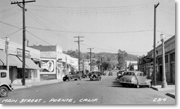 8. What can you tell me about La Puente Valley and the city of La Puente?
8. What can you tell me about La Puente Valley and the city of La Puente?
The city of La Puente grew out of John Rowland's half of the original 49,000-acre Rancho La Puente. In 1885, developers George Stimson and A.E. Pomeroy bought 20 acres from Rowland's son, Albert, and the next year they began laying out the township of La Puente during the peak of Southern California's building boom. In 1887, the Rowland Hotel, the Stimson Building, and the community's first church were the first three buildings to be constructed in the new downtown. The town survived major fires in 1897 and 1923 and evolved as a prosperous agricultural community during the first half of the twentieth century. During the 1930s it was especially renowned for its fruit and walnut groves, even boasting the world's largest walnut-packing plant. Like other Southern California communities, its groves gave way to development after World War II, and today La Puente - which means "The Bridge" - is a mostly residential community of more than 41,200 residents. It was incorporated as a city on August 1, 1956. More information about the history of La Puente can be found in the following sources:

Website Links:
Print Sources:
- Rowland, Leonore. Romance of La Puente Rancho. 1958.
- History of La Puente Valley, California. La Puente Journal, 1960.
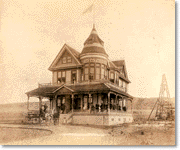
Images:
- Main Street in La Puente, 1930s
[Courtesy of Cecelia Wictor] - Panoramic view of downtown La Puente, c, 1940s
[Courtesy of the La Puente Valley Historical Society] - Hotel Rowland in La Puente, c. 1880s
[Courtesy of Cecelia Wictor] - Puente townsite from Puente Hill, c. 1930s
[Courtesy of Cecelia Wictor] - C. C. Stafford feed mill, c. 1940s
[Courtesy of Cecelia Wictor]
 9. What can you tell me about the schools of La Puente Valley?
9. What can you tell me about the schools of La Puente Valley?
The school system of La Puente Valley dates back to 1887, when the Hudson School District was formed; a year later, a mere sixteen students attended the district's only school, a one-room building resembling a church. In 1915, the La Puente Union High School District was formed. The district grew over the years and survived Depression-era cutbacks and a 1933 earthquake. Post-war growth in the valley spurred similar growth in the school system, so that in 1951, four new school buildings were built for about half a million dollars. Today the valley is known for its excellent school system. More information about the schools in the region can be found in the following sources:
Website Links: |
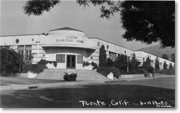
|
Print Sources:
- History of La Puente Valley, California. Reprinted from the October 6, 1960, 50th Anniversary Edition of La Puente Valley Journal and Supplementary Articles, 1910-1960.
- Hacienda Heights: Growing with Pride. Ideas Unlimited, 1970.

Images:
- Hudson School and children, c. 1910
[Courtesy of Cecelia Wictor] - Puente High School gymnasium, c. 1940s
[Courtesy of Cecelia Wictor] - Hudson Elementary School in La Puente, c. 1950s
[Courtesy of Cecelia Wictor]
![]()
Agoura Hills |
Antelope Valley |
Carson |
Catalina Island |
Claremont |
East Los Angeles
Gardena |
Lakewood |
La Puente Valley |
Pico Rivera |
San Dimas |
San Fernando
San Gabriel |
South Gate |
Willowbrook






